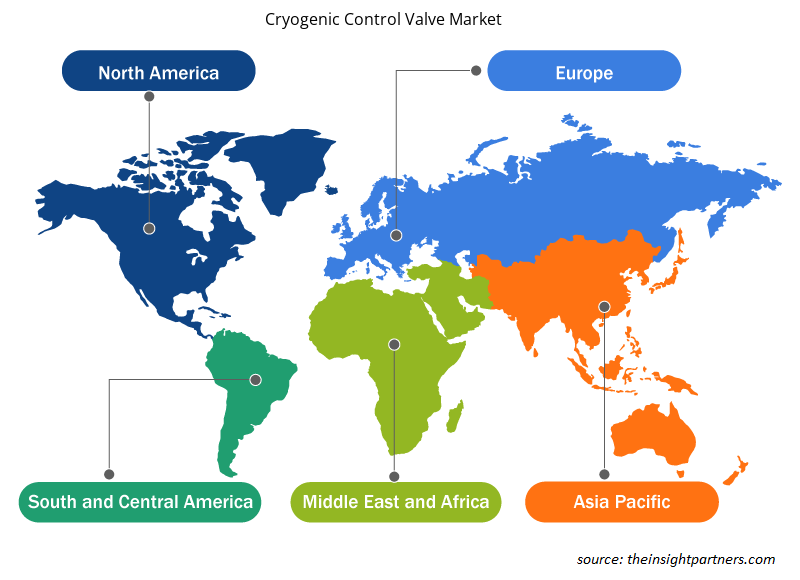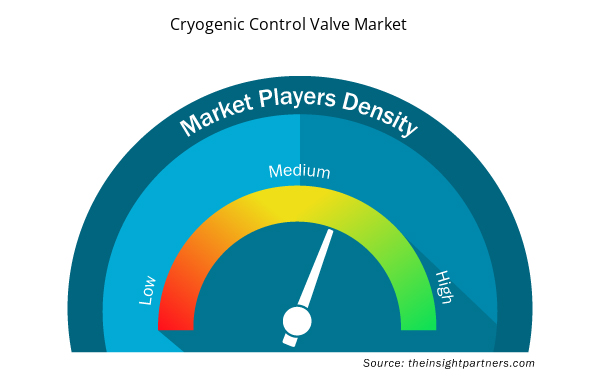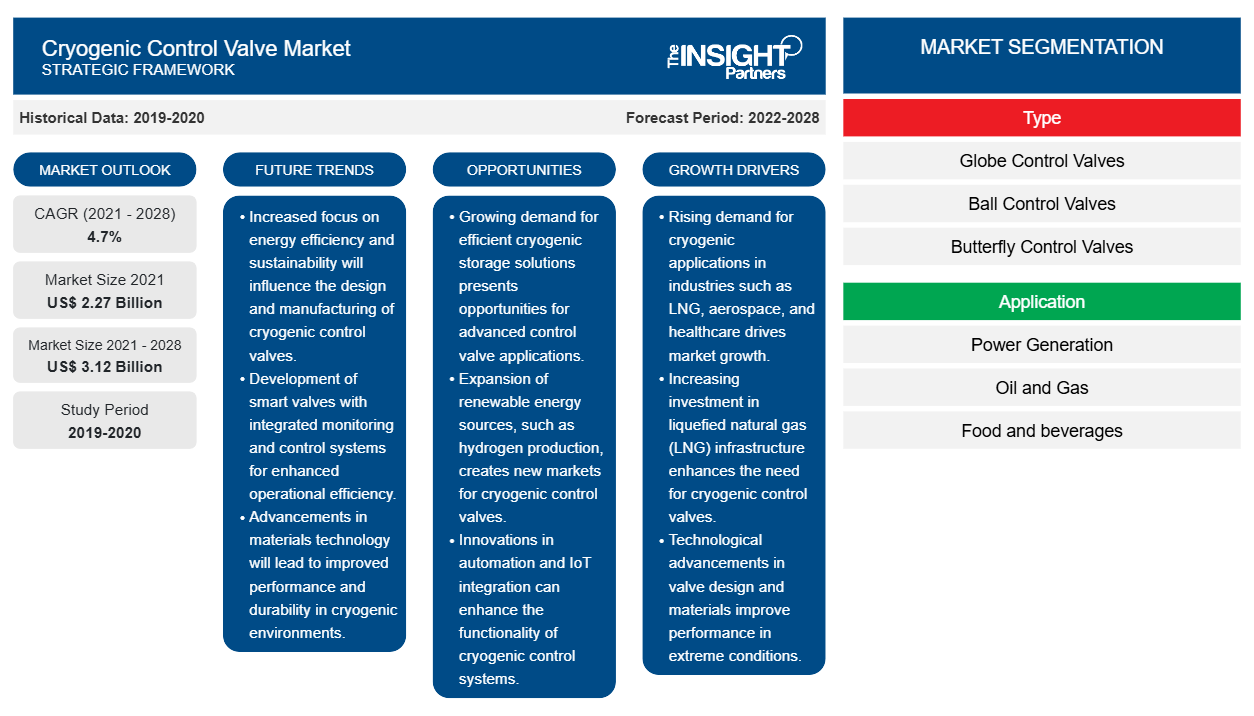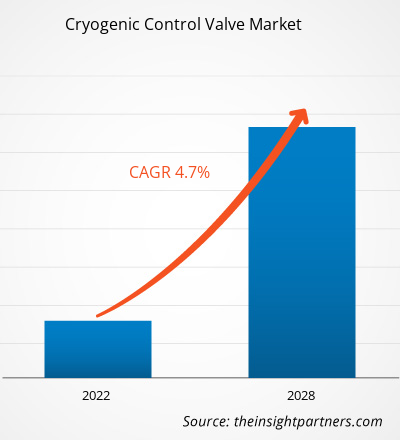Se espera que el mercado de válvulas de control criogénico crezca de US$ 2.267,07 millones en 2021 a US$ 3.117,79 millones en 2028; se estima que crecerá a una CAGR del 4,7% durante 2021-2028.
Existe un aumento en la demanda de gases industriales tanto en países desarrollados como en desarrollo, como el Reino Unido, los EE. UU., Australia, Alemania, India y China. Se producen diversos gases industriales para aplicaciones específicas en diversas industrias. Algunos de los gases industriales más utilizados son el oxígeno, el nitrógeno, el argón, el dióxido de carbono, el helio, el hidrógeno y el acetileno, entre otros. Las válvulas criogénicas se utilizan ampliamente para el transporte, el uso y el almacenamiento de gases licuados como el gas natural comprimido (GNC) y el gas natural licuado (GNL). En la India, las ventas de automóviles a GNC registraron un crecimiento interanual del 49% en el año fiscal 2021 y su participación de mercado ha crecido del 4% en 2020 al 6% en 2021. La demanda de gases licuados, como el nitrógeno líquido, está aumentando en la crioterapia para eliminar anomalías de la piel, el transporte y la congelación de productos alimenticios, el enfriamiento de superconductores y la criopreservación de sangre.
Para la producción de oxígeno, las válvulas criogénicas se utilizan en plantas de separación de aire a gran escala. La creciente demanda de oxígeno en los últimos tiempos también es un factor impulsor que contribuye al crecimiento del mercado de válvulas de control criogénicas. Los diversos tipos de válvulas criogénicas necesarias para la industria del gas son la válvula de compuerta, la válvula de retención, la válvula de globo, la válvula de retención de elevación, la válvula de bola, la válvula de manguito, la válvula de retención de parada, la válvula de mariposa, la válvula de retención de disco basculante, la válvula de tapón, la válvula de diafragma, la válvula de seguridad y la válvula de alivio de presión. Con el aumento de la demanda de gases industriales en diversas industrias como la química, la petroquímica, la siderurgia, la minería, la protección del medio ambiente, los metales, la medicina, la biotecnología, la farmacéutica, etc., también se prevé que la demanda de las válvulas mencionadas aumente considerablemente.
Personalice este informe según sus necesidades
Obtendrá personalización en cualquier informe, sin cargo, incluidas partes de este informe o análisis a nivel de país, paquete de datos de Excel, así como también grandes ofertas y descuentos para empresas emergentes y universidades.
- Obtenga las principales tendencias clave del mercado de este informe.Esta muestra GRATUITA incluirá análisis de datos, desde tendencias del mercado hasta estimaciones y pronósticos.
Impacto de la pandemia de COVID-19 en el mercado de válvulas de control criogénico
La pandemia de COVID-19 ha influido negativamente en la industria del petróleo y el gas en general debido a la considerable interrupción de las actividades de la cadena de suministro, junto con el cierre del comercio internacional por parte de varios países a raíz de la pandemia. Además, los precios mundiales del petróleo y el gas se desplomaron significativamente debido a la demanda limitada y la producción continua de los países productores de petróleo, lo que provocó una disminución considerable de las actividades de producción entre los principales países productores de petróleo. En consecuencia, la interrupción de las actividades de petróleo y gas interrumpió la demanda de productos y servicios relacionados, como las válvulas criogénicas.
En medio de la pandemia de COVID-19, el negocio de procesamiento de alimentos ha aumentado significativamente debido al aumento de la demanda de bienes de consumo. Este desarrollo ha estabilizado el uso de válvulas criogénicas en cierta medida. Por lo tanto, la pandemia ha afectado negativamente al mercado de válvulas de control criogénico durante los dos primeros trimestres de 2020. Sin embargo, la demanda se reanudó con la continuación de las actividades económicas. Por lo tanto, se proyecta que el mercado global recupere la falta de demanda en los próximos meses y los años posteriores.
Perspectivas del mercado de válvulas de control criogénico
Demanda creciente de combustibles para FSRU y FPSO Crecimiento del mercado de válvulas de control criogénico
En los últimos tiempos, la demanda de unidades flotantes de producción, almacenamiento y descarga (FPSO) y unidades flotantes de regasificación y almacenamiento (FSRU) ha aumentado considerablemente. Las unidades FPSO se utilizan ampliamente para el procesamiento y la producción de hidrocarburos y el almacenamiento de petróleo en la industria del petróleo y el gas. Para la transferencia y transición de gas natural licuado (GNL) a través de canales oceánicos, se requiere una FSRU. Según la Organización de Países Exportadores de Petróleo (OPEP), se prevé que la demanda mundial de petróleo crezca de 38 millones de barriles por día a 115 millones de barriles por día para 2025, con un crecimiento promedio anual de 1,6 millones de barriles por día o 1,7%, de 2002 a 2025. Teniendo en cuenta la viabilidad tecnológica, la movilidad, la disponibilidad, la programación, la flexibilidad comercial y el menor costo, las FSRU están ganando popularidad en todo el mundo. Con el aumento del uso de gases naturales, se anticipa que Asia Pacífico será el mercado más grande de FSRU en los próximos años. Las válvulas criogénicas de los distintos tipos se utilizan ampliamente en unidades FPSO y FSRU. Se espera que esto impulse el mercado de válvulas criogénicas en todo el mundo.
Perspectivas de mercado basadas en tipos
Según el tipo, el mercado de válvulas de control criogénico se subdivide en válvulas de control de globo, válvulas de control de bola, válvulas de control de mariposa y otras. En 2020, el segmento de otras válvulas representó la mayor participación de mercado.
Perspectivas de mercado basadas en aplicaciones
Según la aplicación, el mercado de válvulas de control criogénico se segmenta en generación de energía, petróleo y gas, alimentos y bebidas, y otras aplicaciones. En 2020, el segmento de petróleo y gas representó la mayor participación de mercado.
Los actores que operan en el mercado de válvulas de control criogénico adoptan estrategias como fusiones, adquisiciones e iniciativas de mercado para mantener sus posiciones en el mercado. A continuación, se enumeran algunos desarrollos de los actores clave:
- En junio de 2021, Baker Hughes y Borg CO2 anunciaron un memorando de entendimiento para colaborar en un proyecto de captura y almacenamiento de carbono. Este proyecto servirá como centro para la descarbonización de espacios industriales en la región de Viken, en Noruega.
- En marzo de 2021, Emerson presentó una serie de válvulas solenoides de tres y dos vías que respaldan el requisito de los fabricantes de equipos originales de desarrollar equipos y máquinas más compactos sin comprometer el rendimiento del control de fluidos.
Perspectivas regionales del mercado de válvulas de control criogénico
Los analistas de Insight Partners explicaron en detalle las tendencias y los factores regionales que influyen en el mercado de válvulas de control criogénico durante el período de pronóstico. Esta sección también analiza los segmentos y la geografía del mercado de válvulas de control criogénico en América del Norte, Europa, Asia Pacífico, Oriente Medio y África, y América del Sur y Central.

- Obtenga datos regionales específicos para el mercado de válvulas de control criogénico
Alcance del informe de mercado de válvulas de control criogénico
| Atributo del informe | Detalles |
|---|---|
| Tamaño del mercado en 2021 | US$ 2,27 mil millones |
| Tamaño del mercado en 2028 | US$ 3.12 mil millones |
| CAGR global (2021-2028) | 4,7% |
| Datos históricos | 2019-2020 |
| Período de pronóstico | 2022-2028 |
| Segmentos cubiertos | Por tipo
|
| Regiones y países cubiertos | América del norte
|
| Líderes del mercado y perfiles de empresas clave |
|
Densidad de actores del mercado de válvulas de control criogénico: comprensión de su impacto en la dinámica empresarial
El mercado de válvulas de control criogénico está creciendo rápidamente, impulsado por la creciente demanda de los usuarios finales debido a factores como la evolución de las preferencias de los consumidores, los avances tecnológicos y una mayor conciencia de los beneficios del producto. A medida que aumenta la demanda, las empresas amplían sus ofertas, innovan para satisfacer las necesidades de los consumidores y aprovechan las tendencias emergentes, lo que impulsa aún más el crecimiento del mercado.
La densidad de actores del mercado se refiere a la distribución de las empresas o firmas que operan dentro de un mercado o industria en particular. Indica cuántos competidores (actores del mercado) están presentes en un espacio de mercado determinado en relación con su tamaño o valor total de mercado.
Las principales empresas que operan en el mercado de válvulas de control criogénico son:
- Compañía Baker Hughes
- Compañía Eléctrica Emerson
- Corporación Flowserve
- Velan Inc.
- Compañía KORVAL, Ltd.
Descargo de responsabilidad : Las empresas enumeradas anteriormente no están clasificadas en ningún orden particular.

- Obtenga una descripción general de los principales actores clave del mercado de válvulas de control criogénico
El mercado global de válvulas de control criogénico se ha segmentado como se menciona a continuación:
Por tipo
- Válvulas de control de globo
- Válvulas de control de bola
- Válvulas de control de mariposa
- Otros
Por aplicación
- Generación de energía
- Petróleo y gas
- Alimentos y bebidas
- Otras aplicaciones
Por geografía
- América del norte
- A NOSOTROS
- Canadá
- México
- Europa
- Francia
- Alemania
- Italia
- Reino Unido
- Rusia
- Resto de Europa
- Asia Pacífico (APAC)
- Porcelana
- India
- Corea del Sur
- Japón
- Australia
- Resto de APAC
- Oriente Medio y África (MEA)
- Sudáfrica
- Arabia Saudita
- Emiratos Árabes Unidos
- Resto de MEA
- América del Sur (SAM)
- Brasil
- Argentina
- Resto de SAM
Perfiles de empresas
- Compañía Baker Hughes
- Compañía Eléctrica Emerson
- Corporación Flowserve
- Velan Inc.
- Compañía KORVAL, Ltd.
- Larsen & Toubro Sociedad Limitada
- Corporación Neles
- SAMSON ESTADOS UNIDOS
- Válvulas de bac
- Richards Industriales
- Análisis histórico (2 años), año base, pronóstico (7 años) con CAGR
- Análisis PEST y FODA
- Tamaño del mercado Valor/volumen: global, regional, nacional
- Industria y panorama competitivo
- Conjunto de datos de Excel


- Sterilization Services Market
- Sandwich Panel Market
- Underwater Connector Market
- Digital Pathology Market
- Pressure Vessel Composite Materials Market
- Micro-Surgical Robot Market
- Legal Case Management Software Market
- Semiconductor Metrology and Inspection Market
- Arterial Blood Gas Kits Market
- Personality Assessment Solution Market

Report Coverage
Revenue forecast, Company Analysis, Industry landscape, Growth factors, and Trends

Segment Covered
This text is related
to segments covered.

Regional Scope
North America, Europe, Asia Pacific, Middle East & Africa, South & Central America

Country Scope
This text is related
to country scope.
Preguntas frecuentes
With the growing demand for medicines across the world, the requirement for respective cryogenic valves is rising notably. Cryogenic valves are used in manufacturing, testing, and experimenting of various ingredients used for making a medicine. In the ongoing COVID-19 pandemic, Flowserve was providing cryogenic ball valves to Pfizer for helping expand the production capacities of COVID-19 vaccine.
Russia is the world’s second largest natural gas producing country. As per the BP Statistical Review of World Energy 2020, the country produced 679 billion cubic meters natural gas in 2019. APAC comprises world’s fastest growing countries such as India and China. The region is becoming one of the major consumers of natural gas products.
Cryogenic valves are designed to be used in very cold temperatures. Hence, they are most popularly used by companies that work with liquefied natural gas (LNG) or compressed natural gas (CNG). For instance, the oil & gas industry frequently uses cryogenic temperature ranges starting at -238 degrees Fahrenheit (-150 degrees Celsius). Cryogenic valves are kept in a natural closed position to keep cryogenic gases or other media secure and safely contained
The others segment dominate the market, which comprises plug valves, gate valves, pinch valve, and diaphragm valve, among others. Gate valves use linear stem motion for opening and closing of a valve. These valves use parallel or wedge shaped discs as closure members that provide tight sealing. This type of valve is suitable for oil, gas, air, heavy liquids, steam, non-condensing gases, and abrasive and corrosive liquids.
The power generation sector is growing rapidly in developing as well as developed countries across the globe. Among the power generation sector, the demand for compressed natural gas (CNG) and liquefied natural gas (LNG) is increasing substantially. Suitable cryogenic valves are widely used in various compressed natural gas (CNG) and liquefied natural gas (LNG) applications. The main reason for rise in need for compressed natural gas (CNG) is its increasing utility in various sectors.
There is an increase in demand for industrial gases in developed as well as developing countries such as the UK, the US, Australia, Germany, India, and China. Various industrial gases are produced for specific applications in various industries. Some of the majorly used industrial gases are oxygen, nitrogen, argon, carbon dioxide, helium, hydrogen, and acetylene, among others. Cryogenic valves are widely used for transport, use, and storage of liquefied gases such as compressed natural gas (CNG) and liquefied natural gas (LNG).
Trends and growth analysis reports related to Manufacturing and Construction : READ MORE..
The List of Companies - Cryogenic Control Valve Market
- Baker Hughes Company
- Emerson Electric Co.
- Flowserve Corporation
- Velan Inc.
- KORVAL Co., Ltd.
- Larsen & Toubro Limited
- Neles Corporation
- SAMSON USA
- Bac Valves
- Richards Industrials
The Insight Partners performs research in 4 major stages: Data Collection & Secondary Research, Primary Research, Data Analysis and Data Triangulation & Final Review.
- Data Collection and Secondary Research:
As a market research and consulting firm operating from a decade, we have published and advised several client across the globe. First step for any study will start with an assessment of currently available data and insights from existing reports. Further, historical and current market information is collected from Investor Presentations, Annual Reports, SEC Filings, etc., and other information related to company’s performance and market positioning are gathered from Paid Databases (Factiva, Hoovers, and Reuters) and various other publications available in public domain.
Several associations trade associates, technical forums, institutes, societies and organization are accessed to gain technical as well as market related insights through their publications such as research papers, blogs and press releases related to the studies are referred to get cues about the market. Further, white papers, journals, magazines, and other news articles published in last 3 years are scrutinized and analyzed to understand the current market trends.
- Primary Research:
The primarily interview analysis comprise of data obtained from industry participants interview and answers to survey questions gathered by in-house primary team.
For primary research, interviews are conducted with industry experts/CEOs/Marketing Managers/VPs/Subject Matter Experts from both demand and supply side to get a 360-degree view of the market. The primary team conducts several interviews based on the complexity of the markets to understand the various market trends and dynamics which makes research more credible and precise.
A typical research interview fulfils the following functions:
- Provides first-hand information on the market size, market trends, growth trends, competitive landscape, and outlook
- Validates and strengthens in-house secondary research findings
- Develops the analysis team’s expertise and market understanding
Primary research involves email interactions and telephone interviews for each market, category, segment, and sub-segment across geographies. The participants who typically take part in such a process include, but are not limited to:
- Industry participants: VPs, business development managers, market intelligence managers and national sales managers
- Outside experts: Valuation experts, research analysts and key opinion leaders specializing in the electronics and semiconductor industry.
Below is the breakup of our primary respondents by company, designation, and region:

Once we receive the confirmation from primary research sources or primary respondents, we finalize the base year market estimation and forecast the data as per the macroeconomic and microeconomic factors assessed during data collection.
- Data Analysis:
Once data is validated through both secondary as well as primary respondents, we finalize the market estimations by hypothesis formulation and factor analysis at regional and country level.
- Macro-Economic Factor Analysis:
We analyse macroeconomic indicators such the gross domestic product (GDP), increase in the demand for goods and services across industries, technological advancement, regional economic growth, governmental policies, the influence of COVID-19, PEST analysis, and other aspects. This analysis aids in setting benchmarks for various nations/regions and approximating market splits. Additionally, the general trend of the aforementioned components aid in determining the market's development possibilities.
- Country Level Data:
Various factors that are especially aligned to the country are taken into account to determine the market size for a certain area and country, including the presence of vendors, such as headquarters and offices, the country's GDP, demand patterns, and industry growth. To comprehend the market dynamics for the nation, a number of growth variables, inhibitors, application areas, and current market trends are researched. The aforementioned elements aid in determining the country's overall market's growth potential.
- Company Profile:
The “Table of Contents” is formulated by listing and analyzing more than 25 - 30 companies operating in the market ecosystem across geographies. However, we profile only 10 companies as a standard practice in our syndicate reports. These 10 companies comprise leading, emerging, and regional players. Nonetheless, our analysis is not restricted to the 10 listed companies, we also analyze other companies present in the market to develop a holistic view and understand the prevailing trends. The “Company Profiles” section in the report covers key facts, business description, products & services, financial information, SWOT analysis, and key developments. The financial information presented is extracted from the annual reports and official documents of the publicly listed companies. Upon collecting the information for the sections of respective companies, we verify them via various primary sources and then compile the data in respective company profiles. The company level information helps us in deriving the base number as well as in forecasting the market size.
- Developing Base Number:
Aggregation of sales statistics (2020-2022) and macro-economic factor, and other secondary and primary research insights are utilized to arrive at base number and related market shares for 2022. The data gaps are identified in this step and relevant market data is analyzed, collected from paid primary interviews or databases. On finalizing the base year market size, forecasts are developed on the basis of macro-economic, industry and market growth factors and company level analysis.
- Data Triangulation and Final Review:
The market findings and base year market size calculations are validated from supply as well as demand side. Demand side validations are based on macro-economic factor analysis and benchmarks for respective regions and countries. In case of supply side validations, revenues of major companies are estimated (in case not available) based on industry benchmark, approximate number of employees, product portfolio, and primary interviews revenues are gathered. Further revenue from target product/service segment is assessed to avoid overshooting of market statistics. In case of heavy deviations between supply and demand side values, all thes steps are repeated to achieve synchronization.
We follow an iterative model, wherein we share our research findings with Subject Matter Experts (SME’s) and Key Opinion Leaders (KOLs) until consensus view of the market is not formulated – this model negates any drastic deviation in the opinions of experts. Only validated and universally acceptable research findings are quoted in our reports.
We have important check points that we use to validate our research findings – which we call – data triangulation, where we validate the information, we generate from secondary sources with primary interviews and then we re-validate with our internal data bases and Subject matter experts. This comprehensive model enables us to deliver high quality, reliable data in shortest possible time.


 Obtenga una muestra gratuita de este informe
Obtenga una muestra gratuita de este informe